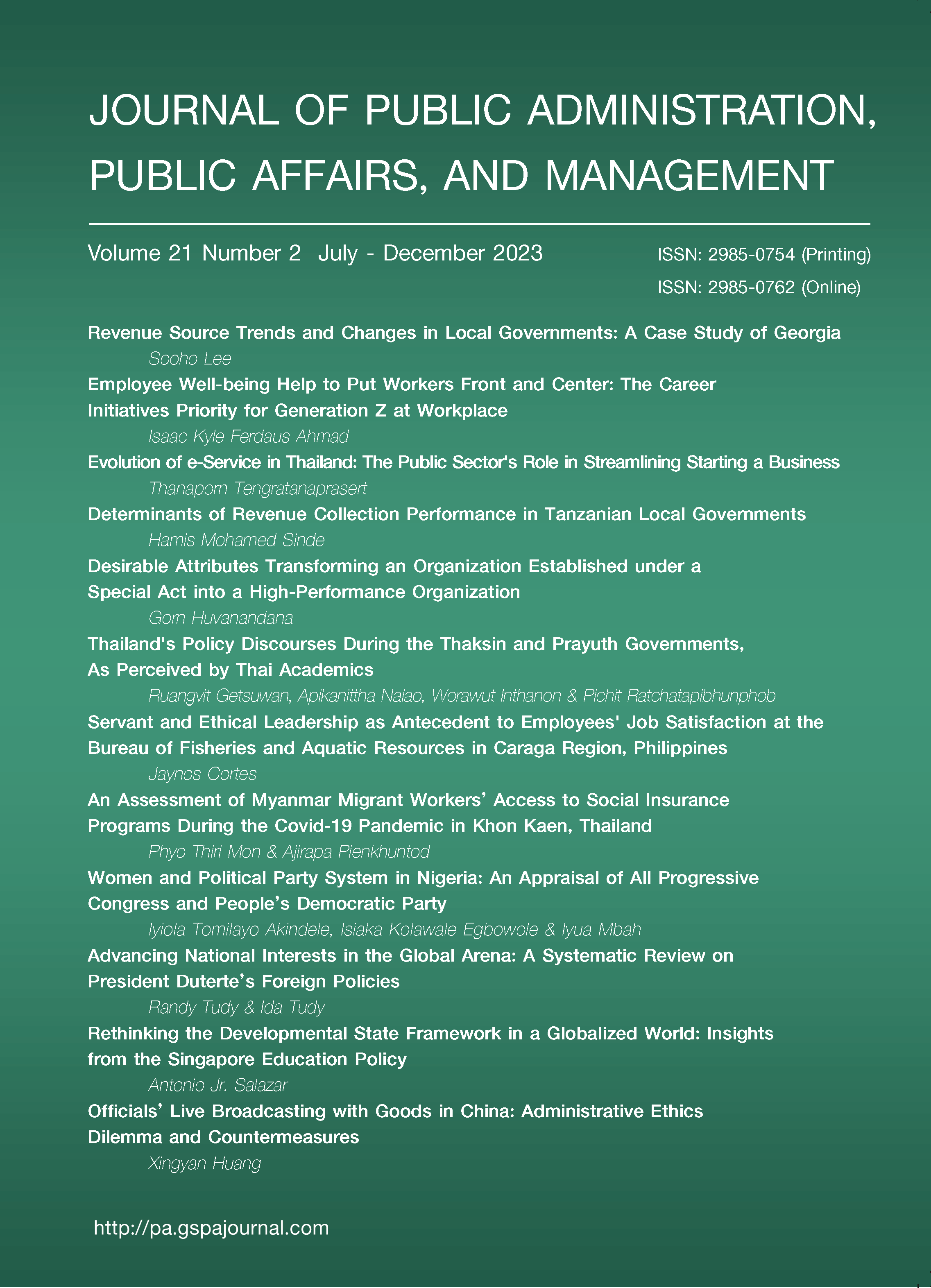[Retracted Article] Desirable Attributes Transforming an Organization Established under a Special Act into a High-Performance Organization
Keywords:
Management, Agentification, Public Governance, High-Performance Organization, Public SectorAbstract
บทความเรื่องนี้ถูกถอดบทความ เนื่องจากคณะกรรมการบริหารโครงการวารสารและเอกสารทางวิชาการ คณะรัฐประศาสนศาสตร์ สถาบันบัณฑิตพัฒนบริหารศาสตร์ ตรวจพบความคล้ายคลึงกันกับบทความเรื่อง "ความสามารถในการบริหารจัดการและการสนองตอบต่อภาวะวิกฤติการแพร่ระบาดของไวรัสโควิด-19 ขององค์การที่จัดตั้งตามพระราชบัญญัติเฉพาะ" ที่ได้รับการตีพิมพ์ในวารสารการจัดการภาครัฐและภาคเอกชน ปีที่ 30 ฉบับที่ 2 เดือนกรกฎาคม – ธันวาคม 2566 ซึ่งเขียนโดยคณะผู้เขียนชุดเดียวกัน
This research aims to examine the key attributes of organizations established under special acts within the context of Thai society that contribute to their status as High-Performance Organizations, effectively achieving their missions. Furthermore, it seeks to propose policies for enhancing the adaptability and responsiveness of these organizations to meet the needs of the nation and its citizens. Qualitative research methods, including document analysis, in-depth interviews, and group interviews, were employed to gather insights. The study involved a purposive sample of nine selected agencies. Data analysis involved concluding the information, identifying patterns, and understanding the phenomena under investigation, ultimately allowing for the formulation of concrete and pertinent policy recommendations. The study's findings reveal several desirable characteristics for organizations established under special acts to achieve High-Performance status within the Thai societal context. These characteristics include:
Organizational Structure: The ability to swiftly adapt and respond to changes (Adaptability), coupled with flexibility (Agility), responsiveness to stakeholders, and the continuous development of work processes and technology.
Organizational Culture: Focusing on raising personnel awareness of service quality, prioritizing continuous learning, valuing competencies, and promoting shared values that prioritize the nation's interests.
Stakeholder Emphasis: Recognizing the importance of stakeholders and responding to external factors, which aids in understanding the genuine needs of service recipients and gaining support from the public sector and network partners.
Member Behavior: Encouraging members within the organization to respond to external factors and appreciate the significance of stakeholders. When such responses align with the organizational culture, they steer the behavior of all individuals within the organization towards shared goals, contributing positively to goal and mission attainment.
Furthermore, the study's results enable the synthesis of a successful organizational ecosystem for organizations established under special acts, which comprises both internal and external factors. At the individual level, effective collaboration and good governance among the organization's board of directors, directors, and the administrative office are essential. At the organizational level, a flexible and adaptable structure, coupled with a focus on cooperation and opportunities for other sectors to participate, is crucial. External success factors encompass freedom from political interference and support from the government and network partners.
References
Brokaw, G. S., & Mullins, J. M. (2006). In pursuit of higher performance-part I. Public Manager, 35(4), 28-33.
De Waal, A. A. (2007). The characteristics of high-performance organization. Business Strategy Series, 8(3), 179-185.
Henry, N. (1995). Public Administration and Public Affairs. Englewood Cliffs: Prentice-Hall.
Holbeche, L., & Park, R. (2004). HR and the high-performance organization. Strategic HR Review, 3(2), 32-35.
Hood, C. C. (1991). A public management for all seasons? Public Administration. 69, 3-19.
Lorsuwannarat, T. (2016). Modern Organization Theory. Bangkok: Rattanatrai.
Osborne, S.P. (2010). Introduction: The (new) public governance: A suitable case for treatment? In Osborne, S. P. (Ed.). The New Public Governance? Emerging Perspectives on the Theory and Practice of Public Governance. London: Routledge.
Pollitt, C., Bathgate, K., Caulfield, J., Smullen, A., & Talbot, C. (2001). Agency fever? Analysis of an international policy fashion. Journal of Comparative Policy Analysis: Research and Practice. 3(3), 271-290.
Sadka, E. (2006). Public-private partnerships: A public economics perspective. IMF Working Paper No. 06/77. Retrieved from https://ssrn.com/abstract=901868.
Tangsupvattana, A., Sawasdee, S. N., & Chumpon, P. (2011). Words and Ideas in Contemporary Politics. 3rd ed. Bangkok: Chulalongkorn University.
Van de Walle, S., & Hammerschmid, G. (2011). The impact of the new public management: Challenges for coordination and cohesion in European public sectors. Halduskultuur, 12(2), 190-209.
Downloads
Published
Issue
Section
License

This work is licensed under a Creative Commons Attribution-NonCommercial-NoDerivatives 4.0 International License.



